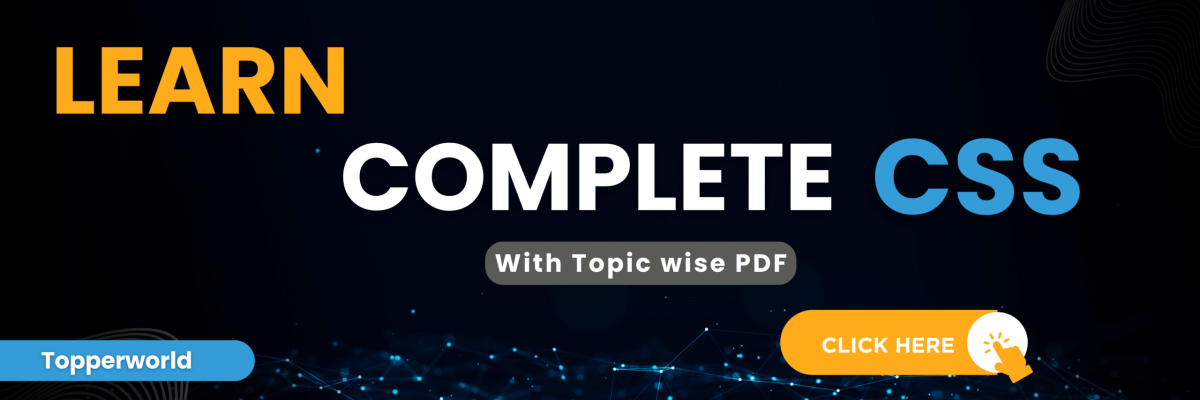CSS Icons
CSS icons typically refer to the use of Cascading Style Sheets (CSS) to create and style icons on a web page. Icons are visual symbols that represent actions, objects, or concepts. Instead of using image files for icons, CSS allows developers to create and customize icons using various CSS properties and pseudo-elements.
In the below PDF we discuss about CSS Icons in detail in simple language, Hope this will help in better understanding.
Implementation Techniques:
Now that we understand the benefits of CSS icons, let’s explore some common techniques for implementing them:
1. Icon Fonts:
Icon fonts, such as Font Awesome and Material Icons, are sets of vector icons embedded in a font format. By including the font file in your project and applying the appropriate CSS classes, you can effortlessly integrate a wide range of icons into your web pages.
<link rel="stylesheet" href="https://cdnjs.cloudflare.com/ajax/libs/font-awesome/5.15.3/css/all.min.css">
<i class="fas fa-heart"></i>
2. CSS Pseudo-elements:
CSS pseudo-elements, such as ::before and ::after, can be used to insert icons directly into HTML elements without the need for additional markup. This technique is particularly handy for decorative icons or icons associated with links.
custom-icon::before {
content: '\2022'; /* Unicode character for a bullet point, can be replaced with other icons */
color: #3498db;
font-size: 20px;
margin-right: 5px;
}3. SVG Icons:
Scalable Vector Graphics (SVG) provide a lightweight and resolution-independent option for icons. SVG icons can be embedded directly into HTML or referenced in the CSS background property.
svg-icon {
background: url('icon.svg') no-repeat;
width: 24px;
height: 24px;
} Advantages of Using CSS Icons:
- Scalability:
CSS icons are scalable without loss of quality. Unlike traditional image icons, which may pixelate when resized, CSS icons can be easily adjusted to fit different screen sizes and resolutions. This responsiveness ensures a consistent and visually pleasing experience across various devices. - Performance:
By utilizing CSS for icons, you reduce the need for additional HTTP requests associated with image files. This can lead to faster load times, contributing to a more efficient and optimized website. Improved performance is crucial for retaining user engagement and satisfying the expectations of modern web users. - Customization:
CSS icons offer extensive customization options. Designers can easily modify the color, size, and style of icons to align with the overall aesthetic of the website. This flexibility allows for a cohesive design language and enhances brand consistency. - Accessibility:
Icons, when appropriately implemented using CSS, can contribute to improved accessibility. By incorporating proper semantic markup and using ARIA (Accessible Rich Internet Applications) attributes, developers can ensure that icons are understandable and navigable for users with disabilities, such as those who rely on screen readers.
Application of CSS Borders:
- Card Design:
Borders are often used to frame card components, providing a clean and organized look to content. - Button Styling:
Applying borders creatively to buttons can enhance their visual appeal and make them stand out. - Image Frames:
Using borders to create frames around images can draw attention to visual elements on a webpage
Related Question
CSS icons refer to graphical symbols or images that are created and styled using Cascading Style Sheets (CSS) to enhance the visual appearance of a website or web application.
Unlike traditional image icons, CSS icons are created using CSS properties and pseudo-elements. They are often vector-based, scalable, and can be easily customized through CSS without the need for additional image files.
Yes, CSS icons can be animated using CSS animations and transitions. Developers can apply animations to icons, such as spin, fade, or bounce effects, to enhance the user experience.
Yes, you can apply multiple borders to an element by using the box-shadow property to create additional borders with different colors or styles.
.
Relevant
The Ultimate Guide to CSS
A Complete Guide to CSS
A Complete Guide to CSS
The Ultimate Guide to CSS
CSS Background WhatsApp Group Join
The Ultimate Guide to CSS
CSS Units – Explained with




Can you be more specific about the content of your article? After reading it, I still have some doubts. Hope you can help me.